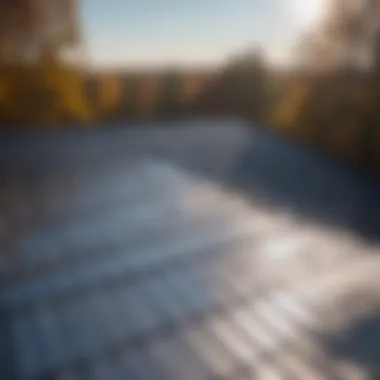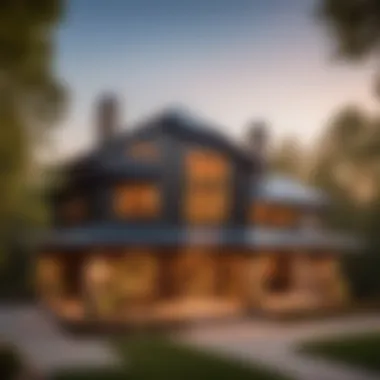Materials:
- Steel roofing panels (measured according to roof size)
- Underlayment material (such as synthetic roofing felt)
- Screws and nails specific for steel roofing installation
- Protective gear (gloves, goggles)
- Roofing adhesive
- Sealant and caulking
- Roofing tape
- Roofing nails
DIY Steps:
- Assessment: Evaluate the condition of the existing roof, ensuring it can bear the weight of the steel roof.
- Planning: Measure the roof dimensions accurately to determine the amount of steel roofing panels needed.
- Preparation: Clear the roof of any debris and ensure a smooth surface for installation.
- Underlayment Installation: Apply the underlayment material evenly across the roof to provide a moisture barrier.
- Steel Panel Placement: Start from one side of the roof and fasten the steel panels, overlapping them securely.
Technical Aspects:
- Tools: Roofing hammer, drill with metal bits, measuring tape, chalk line
- Timing: Plan for a dry day with moderate temperature for optimal adhesion
- Techniques: Use proper fastening techniques to prevent water infiltration and ensure roof integrity
DIY Project Process:


- Steel Panel Installation: Secure the first panel at the eaves, ensuring alignment and proper fastening.
- Overlap and Fastening: Overlap subsequent panels as per manufacturer's instructions, using appropriate screws/nails.
- Ridge and Edging: Install ridge caps and edging to seal off edges and prevent water seepage.
- Inspection and Completion: Check for any loose fastenings or gaps, seal with caulking if necessary.
Troubleshooting Tips:


- If panels are not aligning, double-check measurements and adjust accordingly
- Ensure proper ventilation to prevent moisture buildup under the steel roof
We hope this detailed guide provides valuable insights for your steel roof project!
Introduction


In the realm of roofing materials, steel stands out as a durable and versatile option that offers numerous advantages. This article delves deep into the topic of installing a steel roof over existing asphalt shingles, shedding light on the benefits and considerations that homeowners should be aware of before undertaking this upgrade. By exploring the unique characteristics of steel roofing and the specific advantages it holds over traditional materials, readers will gain valuable insights into why this choice can be a game-changer for their home improvement projects.
Overview of Steel Roofing
Types of Steel Roofing Materials
Steel roofing comes in various forms, ranging from corrugated sheets to interlocking panels, each offering its own set of benefits. The resilience of steel, coupled with its lightweight nature, makes it a popular choice for homeowners looking for longevity and protection against the elements. The high tensile strength of steel ensures that it can withstand harsh weather conditions, making it a reliable option for those seeking durability in their roofing solutions.
Advantages of Steel Roofing over Traditional Materials
The advantages of opting for steel roofing over traditional materials are aplenty. Steel roofs boast exceptional longevity, often outlasting other roofing materials by decades. Furthermore, steel is inherently fire-resistant and can reduce energy costs by reflecting the sun's rays away from the structure. Its eco-friendly nature also makes it an attractive choice for environmentally-conscious homeowners seeking sustainable roofing options.
Benefits of Installing Steel Roof Over Asphalt Shingles
Durability and Longevity
One of the key benefits of installing a steel roof over asphalt shingles is the enhanced durability and longevity it provides. Steel roofing can easily last 50 years or more, outperforming traditional shingle roofs by a significant margin. Its resistance to corrosion, cracking, and peeling ensures that homeowners enjoy a low-maintenance roofing solution that stands the test of time.
Energy Efficiency
Steel roofs are known for their energy-efficient properties, helping homeowners save on heating and cooling costs in the long run. By reflecting solar heat and minimizing heat transfer into the attic space, steel roofs contribute to a more comfortable indoor environment and reduce the strain on HVAC systems, leading to potential energy savings.
Enhanced Aesthetic Appeal
Beyond its practical benefits, a steel roof can elevate the aesthetic appeal of a home. With a range of colors, styles, and finishes available, homeowners can customize their steel roof to complement their property's architectural style and personal preferences. Whether aiming for a modern, sleek look or a more traditional appearance, steel roofing offers versatility and visual appeal that can enhance the overall curb appeal of a residence.
Pre-Installation Considerations
When considering the installation of a steel roof over existing asphalt shingles, thorough pre-installation considerations are crucial to ensure a successful and durable outcome. These considerations are the foundation upon which the entire project is built, and neglecting them can lead to costly mistakes and issues down the line.
Assessment of Existing Roof Condition
Inspection for damage or issues
Inspecting the current condition of the roof for any damage or underlying issues is a critical step before proceeding with the installation of a steel roof. By thoroughly examining the shingles, assessing for cracks, missing pieces, or signs of wear and tear, homeowners can identify potential areas of concern that need to be addressed before the steel roof installation begins. This detailed inspection not only ensures a smooth transition to the new roof but also helps in preventing any further damage that may lead to future leaks or structural problems. The meticulous assessment for damage ensures that the new steel roof is installed on a stable and secure surface, maximizing its longevity and performance.
Structural integrity evaluation
Evaluating the structural integrity of the existing roof is paramount to determine if it can support the weight and system of a steel roof. Structural issues such as sagging, rot, or inadequate support can compromise the effectiveness and safety of the new steel roof. By conducting a thorough evaluation, homeowners can address any structural concerns beforehand, thereby avoiding potential risks and ensuring the longevity of their investment. This evaluation also aids in determining if any reinforcement or modifications are needed to uphold the additional weight of the steel roof, safeguarding the integrity of the entire roofing system.
Consultation with Roofing Professionals
Engaging with experienced roofing professionals is a valuable aspect of the pre-installation phase when considering a steel roof upgrade. Their expertise and insights are indispensable in guiding homeowners through the complexities of the project and making informed decisions.
Obtaining expert advice and recommendations
Consulting with roofing professionals allows homeowners to benefit from their specialized knowledge and experience in steel roof installations. These experts can provide tailored advice based on the specific requirements of the property, offering recommendations on the best practices, materials, and techniques to achieve optimal results. By tapping into their expertise, homeowners can navigate potential challenges more effectively, ensuring that the steel roof installation is executed efficiently and proficiently.
Estimation of project costs
Obtaining a detailed estimation of the project costs from roofing professionals is essential for budget planning and financial preparedness. A comprehensive breakdown of the expenses involved in the steel roof installation, including materials, labor, permits, and any unforeseen contingencies, empowers homeowners to make well-informed financial decisions. Understanding the projected costs allows for better budget management and prevents the project from exceeding financial constraints. By obtaining accurate cost estimates upfront, homeowners can embark on the steel roof installation with clarity and confidence, minimizing the risk of budgetary surprises later in the process.
Installation Process
In the scope of this article, the Installation Process carries immense significance as it acts as the pivotal stage where the transformation from an asphalt shingle roof to a durable steel roof takes place. Homeowners contemplating this upgrade must pay careful attention to every detail during the installation process to ensure a seamless and long-lasting end result. The Installation Process encompasses various essential steps that need to be meticulously followed to guarantee structural integrity, energy efficiency, and aesthetic enhancement.
Roof Preparation
Before delving into the actual installation of a steel roof over asphalt shingles, thorough Roof Preparation is crucial. This stage involves two critical aspects: Cleaning and repairing existing shingles as well as Applying protective underlayment, both of which play instrumental roles in establishing a solid foundation for the new steel roof.
Cleaning and repairing existing shingles
Cleaning and repairing existing shingles is a vital step that sets the stage for the success of the entire project. By meticulously cleaning the surface and addressing any damages or issues present in the asphalt shingles, homeowners can ensure smooth adhesion and prevent potential complications during the installation of the steel roof. This process not only enhances the overall durability of the roof but also improves its visual appeal, creating a seamless transition between the old and new roofing materials.
Applying protective underlayment
Another crucial aspect of Roof Preparation is the application of protective underlayment. This protective layer serves as a barrier against moisture infiltration, improving the insulation of the roof and contributing to its longevity. By installing a high-quality underlayment, homeowners can enhance the energy efficiency of their property and protect the underlying structure from potential water damage.
Steel Roof Installation Steps
Once the Roof Preparation is complete, the focus shifts to the Steel Roof Installation Steps, which involve meticulous attention to detail and precision in execution. This stage comprises two primary tasks: Substructure preparation and Panel installation.
Substructure preparation
Substructure preparation is a foundational step in the installation of a steel roof, involving the reinforcement and stabilization of the underlying structure to support the weight of the new roofing material. This process ensures proper load distribution and helps prevent future issues such as sagging or structural damage. By meticulously preparing the substructure, homeowners can rest assured that their steel roof will be securely and durably installed.
Panel installation
The final key step in the Installation Process is Panel installation, where the individual steel panels are fitted and secured onto the prepared substructure. Panel installation demands precision and expertise to ensure consistent alignment, proper fastening, and effective weatherproofing. This step not only determines the visual uniformity and strength of the roof but also influences its overall performance and resistance to environmental factors.
Post-Installation Care
Post-installation care is a critical aspect to consider once the steel roof is in place over existing asphalt shingles. This phase focuses on ensuring the longevity and optimal performance of the newly installed roofing system. Homeowners must pay close attention to maintenance and addressing common issues to protect their investment.
Maintenance Tips
Taking care of your steel roof post-installation is vital to ensure its durability and efficiency over time. This involves regular inspections and adhering to specific cleaning recommendations to maintain the roof's integrity.
Regular inspections
Regular inspections play a pivotal role in identifying any potential issues early on, allowing for prompt repairs and preventing more extensive damage. Homeowners should schedule routine inspections to check for loose panels, rust formation, or any signs of wear and tear. This proactive approach helps in maintaining the structural integrity of the roof and ensures its long-term performance.
Cleaning recommendations
Proper cleaning practices are essential to keep the steel roof in top condition. Using the recommended cleaning solutions and techniques helps prevent dirt buildup, algae growth, and rust formation. Regular cleaning not only enhances the aesthetic appeal of the roof but also extends its lifespan. Homeowners should follow manufacturer guidelines for cleaning and avoid abrasive materials that can damage the surface.
Addressing Common Issues
Being proactive in addressing common roofing issues is vital to sustaining the steel roof's efficiency and preventing costly repairs down the line. Understanding how to deal with leaks and repairs, as well as implementing corrosion prevention measures, are crucial aspects of post-installation care.
Leaks and repairs
Leaks and repairs are common issues that can affect the integrity of the steel roof. Quickly identifying the source of a leak and addressing it promptly can prevent water damage and structural issues. Regular roof inspections help in detecting leaks early, enabling homeowners to take timely action and safeguard their property.
Corrosion prevention
Corrosion prevention measures are essential for steel roofs to maintain their appearance and structural integrity. Implementing coatings or treatments that inhibit rust formation can significantly prolong the roof's lifespan. Homeowners should be aware of environmental factors that can accelerate corrosion and take preventive steps to protect their investment in a steel roof.





